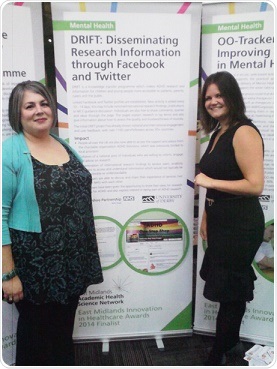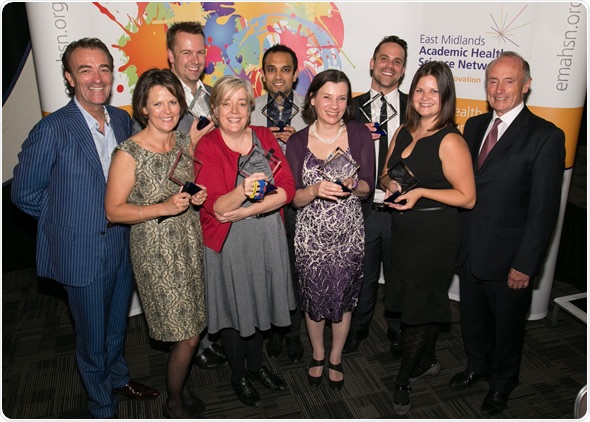Please can you tell us about the ‘Disseminating Research Information through Facebook & Twitter’ (DRIFT) campaign?
It came about through the implementation of another ADHD project called One Stop Shop, which is a collaborative project with Leicestershire Partnership NHS trust (LPT) and ADHD Solutions, a charitable support organization.
 We were aiming to evaluate a nurse-led, multi-agency, drop-in clinic based in a non-NHS location. We wanted to make sure that we could engage the people who were working with us so that we could share the findings of the project.
We were aiming to evaluate a nurse-led, multi-agency, drop-in clinic based in a non-NHS location. We wanted to make sure that we could engage the people who were working with us so that we could share the findings of the project.
It started off as a very small idea and we thought social media would provide a good way of sharing the findings. However, we couldn't find much well researched evidence describing the best way to do this.
We decided to set up a project so we could share the learning in a formal way and offer guidance about how people could set up social media feeds for other types of things if they wanted to.
At the moment, we've been running for over a year, have reached over thirty countries and have over 1,200 followers across Facebook and Twitter.
It's been more successful than we thought it was going to be. We initially thought that it was going to be small-scale, but that just wasn't the case because we reached a lot of people easily.
Why did you choose to run this campaign for Attention Deficit Hyperactivity Disorder (ADHD) research and information as opposed to other conditions?
I work closely with families, young people, and children’s services research team in LPT, which has a specialist ADHD nurse team led by Hanah Sfar-Gandoura. We have been working quite closely with them to try and get other research up and running, which was why we focused on ADHD more than anything else. That's not to say it's not to suitable for anything else, but that's why we chose ADHD.
Why is it important to share research information on ADHD?
Our experience working with ADHD Solutions and the ADHD nurse, showed us that parents genuinely wanted more information. Although they seek support through the internet, many sites are either not relevant or they're more relevant outside of the UK.
The content is not always understandable because it is often technical, clinical research and geared towards professionals. Other content may be inaccurate, such as that found in blogs, for example, and doesn't necessarily give parents the information they really need.
We also know that the UK NICE guidance states that information should be accessible to parents at all stages of diagnosis. We wanted to make sure that they had information so they could make informed decisions as part of a shared care model.
Also, clinical research is ultimately about patients and improving their quality of care and treatment, so we felt people should be able to understand and get a balanced view of clinical research findings. They should be able to understanding what quality research is and what the difference is between a high quality information source and a poor one.
We also wanted to make them aware that something published in the media may not cover everything about that particular subject and there may be other things to consider.
What were the main problems you faced disseminating research information through social media?
We learned not to underestimate the time it takes to maintain engagement, as it can take a while to find the right balance. Although you don't want to overload people with posts all the time, you are at risk of losing followers if you don’t do this regularly enough. It's trying to find that balance.
Unfortunately, the type of content, your demographic and the people you're aiming the page at will determine that and it can take a couple of months to work out what types of things people want to engage with. We found that a few posts every one to two weeks with different focuses, tended to be enough to keep that balance.
Also, you can link your Facebook and Twitter accounts so that you share the same information between the two with one click rather than having to individually post on each site and therefore doubling the work. We weren’t doing that at first, which meant we were wasting time.
Also, in terms of the long-term capacity and sustainability of a site, it’s not necessarily sustainable to only have one person overseeing the site. Another issue is finding the types of information that will attract attention.
A “tweet” only allows for 140 characters, which limits the ability to give a balanced view of research. Conversely, you don't want to put loads of information on there, so that it takes up more than half a page on someone's phone because they just won’t read it. You therefore need to make sure you get the point across within a limited amount of characters.
We wanted to broaden the demographics of our followers and we did use the Facebook and Twitter advertising to do that. That can boost certain types of posts or your page in general. That's how we started to get more information from other countries, although it does cost a little bit of money to do.
It is also essential to have clear moderation procedures in place, in case content is inappropriate. We haven't had any instances where something has been completely inappropriate and we’ve had to intervene, but those procedures do need to be in place before you start. Another tip is to make sure people are available to respond to private messages promptly.
One more point to consider is the possible impact of the research you're posting and what response or consequences it may lead to.
For example, consider whether it could cause concern among parents and perhaps lead them to make decisions about medication without seeking sound medical advice.
You need to be very careful about what you write in that post, to make sure that it's informative but doesn't cause any undesirable consequences. We found it’s not just about sharing a link that takes the viewer to an ITV news report, for example. It’s about giving a little bit of additional information about the content of the link.
How did you decide the level at which the information should be given?
Our primary aim was to direct people to higher quality sources of information and perhaps indicate why those sources were of high quality.
One of the earliest posts was about NICE guidance… what it is and what it is meant for. We directed people to a summary of NICE guidance so they would have an understanding of its role in the quality of healthcare.
Also, if we post research findings, we generally point to an original research article rather than a media report, simply because we want to make sure people understand that there is perhaps a slight difference between the actual findings and what might be published in various other sources.
We tend to link to the abstract, and possibly a secondary resource that explains the research more clearly, such as a support group site. These sites often describe the same study, but in more ordinary, less technical terms.
We like to provide a combination of technical and more ordinary information, so that people aren’t deterred from looking at the original research paper and don’t just rely on what the media are reporting.
We also aim for a clear title that outlines what the findings of a particular project are. We might then identify on the next line any possible limitations involved such as a small sample size, the fact that the research was conducted outside of the UK or that further studies are required before solutions are implemented. This gives viewers an idea of the context in which they should be reading the research.
In what ways do you think the project could be improved going forwards?
We’re still learning how to use the page in a broader way such as finding ways to recruit the research or providing a platform for people to share their journey with us.
We could then start looking at how care could be improved for them or where the research should be focused. This would help us to increase patient and public involvement. We'll continue with what we have been doing for now, but we are ready to consider the broader message we could use.
DRIFT recently won an East Midlands Innovation in Healthcare award. What impact will this have?
People have been able to see what we're doing and we're managing to get our message out there and share our learning with other people, which is very important.
Also, we were awarded £2,000 to develop the project further, which will help us to start looking at the wider usage of the site to allow more two-way engagement and build awareness of how to get involved with research.

Do you have plans to run a similar campaign for other conditions?
That is something that I considered before I started this. It has so many potential uses and before we started this project, the idea was to raise awareness generally about what clinical research is, how to understand the findings and how to access information.
We wanted to help the public appraise the quality of research and the findings being presented so that they have a practical and unbiased understanding of what they read. Possibly, something more generic may be the way forward in the broader context of clinical research.
What are your plans for the future with regards to DRIFT?
We have an immense amount of Facebook and Twitter insight data that we've gathered over the last thirteen months or so and are going to continue gathering until December. Then, we're going to have a look at engagement and any lessons that have been learned, such as the time of day when people are most likely to engage, what type of content they seem to prefer and why. We can then provide advice on how to engage people and the most appropriate way of doing that.
Where can readers find more information?
For more information about DRIFT and to join them on Facebook: https://www.facebook.com/ADHDOneStopShop and Twitter go to: @ADHDonestopshop.
About Gemma Ryan
 Gemma Sinead Ryan is a Senior lecturer in nursing and healthcare practice at University of Derby. For the past year she has also been the Head of health and social care research group within the university. As part of her clinical research background she is also an Honorary research fellow for Leicestershire Partnership NHS Trust and works as an associate lecturer for the Open University.
Gemma Sinead Ryan is a Senior lecturer in nursing and healthcare practice at University of Derby. For the past year she has also been the Head of health and social care research group within the university. As part of her clinical research background she is also an Honorary research fellow for Leicestershire Partnership NHS Trust and works as an associate lecturer for the Open University.
Gemma has a diverse background as a qualified teacher with QTLS (post-16 years) and is also a registered adult nurse and nurse teacher (DeMontfort University).
Her experience includes education, research management, private and NHS healthcare (community and acute setting). She holds a MSc Professional Education and PGCertHE obtained from DeMontfort University; BSc (Hons) Health & Social Care and PGCertAdvancing Healthcare Practice from the Open University.
Gemma has worked on a range of research projects with a particular interest in Facebook and social media in healthcare and healthcare education; she is currently undertaking a doctoral thesis exploring the impact of online social networks on professional accountability in nursing. Other current projects include the use of nurse-led, integrated, multi-agency drop in clinics for children and young people with ADHD and the use of educational websites for parents, education and healthcare professionals.